|

Your guide to recently released books, CDs and other teaching
resources. For additional reviews of French-language resources,
visit Lu, vu,
entendu. With the exception of some classroom sets, items
reviewed are available on loan from the Margaret Wilson Library
at the College. Contact Olivia Hamilton at 416-961-8800 (toll-free
in Ontario 1-888-534-2222), ext 679, or e-mail library@oct.ca. |
Tech smarts and terrific tales
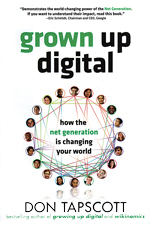 Grown Up Digital Grown Up Digital
by Don Tapscott
The droning instructional style of previous generations of well-meaning educators
no longer suits (if it ever did) students’ learning needs. Don Tapscott argues
that the Internet has changed almost everything for the Net generation – how
they think and act, what they believe. So it stands to reason that once they
arrive in a classroom, their learning needs and expectations must be met in
new ways.
Grown Up Digital is an important elaboration on themes Tapscott introduced
in his 1997 book, Growing Up Digital. The book is based on a survey of more
than 11,000 young people (ages 11 to 30), which revealed a remarkable community
of kids who can multitask, collaborate and scan vast amounts of visual data,
making them information sponges. Tapscott argues that this generation is savvier,
more diverse and more adaptable than previous ones.
He suggests that teachers must change the power dynamics inherent in the teacher-student
relationship. That’s because these students have access to as much information
as their teachers, if not more. Tapscott offers heartfelt advice on how teachers
can adapt their pedagogical philosophy to accommodate this group. He emphasizes
the importance of interacting with students rather than lecturing and suggests
that teachers customize learning to fit student needs. In addition, he encourages
teachers to show their students how to collaborate rather than isolating themselves
in their digital pods.
The book is a great read and delivers a manifesto of pragmatic suggestions
for classroom activities. With the growing technological demographic shift,
teachers need to transform their pedagogical models; this book offers a blueprint
for how to do so. It is a must read for educators teaching the Net generation.
 Grown
Up Digital, McGraw-Hill, Columbus, Ohio, 2009, hardcover, ISBN
978-0-07-150863-6, 368 pages, US$27.95, tel 1-877-833-5524, customer.service@mcgraw-hill.com,
www.mcgraw-hill.com Grown
Up Digital, McGraw-Hill, Columbus, Ohio, 2009, hardcover, ISBN
978-0-07-150863-6, 368 pages, US$27.95, tel 1-877-833-5524, customer.service@mcgraw-hill.com,
www.mcgraw-hill.com
Chadwick Low, OCT, is an English/ESL Teacher at St. Marguerite d’Youville
SS in Brampton.
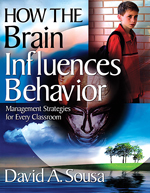
How the Brain Influences Behavior
by David A. Sousa
This insightful book explores the reasons behind student behaviour and translates
what has been learned from neuroscience into practical applications for the
classroom. Sousa describes the factors – environment, age and stress levels
– affecting a child’s behaviour. He offers concrete strategies to deal with
misbehaviour, like using humour to create a positive classroom climate, regular
movement to avoid fidgeting, and multi-sensory activities and quiz games to
keep things fun and interesting.
One of my favourite chapters pertains specifically to boys. Sousa suggests
empowering boys by offering them a way of earning positive attention for appropriate
behaviour. This is by no means a new strategy, but it is often forgotten when
we are facing a very angry child.
I highly recommend this book to anyone interested in understanding and improving
student behaviour. It presents highly technical material in a reader-friendly
way. The appendix is filled with black-line masters that can be used to effect
positive change in any classroom, so that teachers can spend more time teaching
and less time disciplining.
 How
the Brain Influences Behavior: Management Strategies for Every Classroom,
Corwin Press, Thousand Oaks, CA, 2009, softcover, ISBN 978-1-4129-5870-7, 251
pages, US$38.95, tel 1-800-233-9936, webmaster@corwinpress.com, www.corwinpress.com How
the Brain Influences Behavior: Management Strategies for Every Classroom,
Corwin Press, Thousand Oaks, CA, 2009, softcover, ISBN 978-1-4129-5870-7, 251
pages, US$38.95, tel 1-800-233-9936, webmaster@corwinpress.com, www.corwinpress.com
Ken MacKinnon, OCT, is the vice-principal at Tom Longboat Junior PS in Toronto.
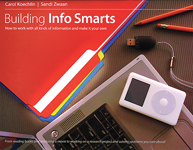 Building Info Smarts Building Info Smarts
by Carol Koechlin and Sandi Zwaan
This short, easy-reading flip book offers students a package of learning tools
to simultaneously develop literacy skills and identify their learning styles.
The authors make good use of visual aids such as flow charts and checklists.
They cover how to access and use all types of information, such as digital
media, personal interviews and traditional books. Chapters deal with everything
from what to look for when reading books or analyzing movies to how to put
together research projects. The book also examines strategies for brainstorming,
for connecting to what students already know, and for helping students who
are developing something new.
My favourite page is a listing of useful web sites and virtual tools for students’
research. The authors also include an important caution about honouring copyright
laws and avoiding plagiarism.
This is a highly useful resource for teaching students at the Junior or Intermediate
levels.
 Building
Info Smarts: How to Find and Use All the Stuff You Need to Make It
Through, Pembroke Publishers, Markham, 2008, softcover, ISBN 978-1-55138-226-5,
32 pages, $12.95, tel 905-477-0650 or 1-800-997-9807, www.pembrokepublishers.com Building
Info Smarts: How to Find and Use All the Stuff You Need to Make It
Through, Pembroke Publishers, Markham, 2008, softcover, ISBN 978-1-55138-226-5,
32 pages, $12.95, tel 905-477-0650 or 1-800-997-9807, www.pembrokepublishers.com
Mary Shaughnessy, OCT, is a part-time adjunct instructor in the faculty of
education at Queen’s University.
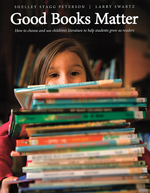
Good Books Matter
by Shelley Stagg Peterson and Larry Swartz
This is essential reading for teachers who want to promote a love of good
books in their classrooms or libraries. Based on the assumption that students
should always be reading rich and rewarding literature, the authors offer a
comprehensive list of books they consider essential within a variety of literary
genres and suggest a range of criteria to use when selecting books for classroom
use.
Each chapter examines a type of literature that targets all ages and grade
levels, including poetry, fairy tales, traditional literature, picture books,
novels, multi-modal genres and nonfiction. The authors explore cross-curricular
connections and suggest ways to encourage student discussion and respond to
what students have read using graphic organizers, multimedia and visual art
forms.
Four key strategies are cited for teaching children’s literature: emotional
response to create a personal connection; reading skills such as predicting,
synthesizing and inferring; analyzing literary elements like plot, character
and setting; and critical reading to motivate students to look at the social,
political and power relationships within a text.
I recommend this book for teachers, literacy coaches and librarians who would
like to enhance their classroom libraries and broaden their understanding of
the importance of rich text selection.
 Good
Books Matter: How to Choose and Use Children’s Literature to Help
Students Grow as Readers, Pembroke Publishers, Markham, 2008, softcover, ISBN
978-1-55138-232-6, 160 pages, $24.95, tel 905-477-0650 or 1-800-997-9807, www.pembrokepublishers.com Good
Books Matter: How to Choose and Use Children’s Literature to Help
Students Grow as Readers, Pembroke Publishers, Markham, 2008, softcover, ISBN
978-1-55138-232-6, 160 pages, $24.95, tel 905-477-0650 or 1-800-997-9807, www.pembrokepublishers.com
Sarah Frost Hunter, OCT, is an early literacy teacher for Primary students
with the Peel DSB.
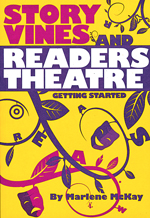
Story Vines and Readers Theatre
by Marlene McKay
Oral storytelling is part of many cultures, but the use of vines as a storytelling
device originated in Africa. A vine can be any physical representation of a
story, such as a braided rope, into which visual prompts or reminders of key
plot points are inserted. For example, prompts to illustrate Three Billy Goats
Gruff might take the form of a tiny troll doll and a drawing of a bridge.
Storytelling using vines brings children with wide-ranging abilities together
as a team. Planning and creating the vines encourages co-operation, vocabulary
development and public speaking and fosters an understanding of narrative techniques
and sequencing. McKay suggests a number of ways to choose a story, create a
story map or storyboard (as used by filmmakers), figure out what visual prompts
to use, and tell the story.
Readers theatre takes storytelling one step further by dramatizing the story
with minimal props and costumes. Children new to the language of instruction
and those who prefer acting to reading will particularly benefit from this
approach. McKay’s reader-friendly handbook answers almost every conceivable
question about story vines and readers’ theatre.
 Story
Vines and Readers Theatre, Portage and Main Press, Winnipeg, 2008,
softcover, ISBN 978-1-55379-155-3, 76 pages, $23.00, tel 1-800-667-9673,
books@pandmpress.com, www.portageandmainpress.com Story
Vines and Readers Theatre, Portage and Main Press, Winnipeg, 2008,
softcover, ISBN 978-1-55379-155-3, 76 pages, $23.00, tel 1-800-667-9673,
books@pandmpress.com, www.portageandmainpress.com
Ruth Latta, OCT, is an author and educator who teaches writing in Ottawa.

Get Yourself Ready for University
by Diane Cameron
This handbook helps university-bound students inform themselves of their options
and make important decisions about school choices, majors, housing and financing.
The book includes worksheets, available for download online, and questionnaires
that can be completed in sequence or independently. A wealth of information
and advice is offered, making this a comprehensive tool for any student considering
university application. This would be an excellent handbook for university
preparation workshops. It is also a worthy resource for parents, who can work
through it with their teenagers before applying to university.
 Get
Yourself Ready for University: The High School Student’s Self-Help
Handbook, Data Based Directions, Barrie, 2008, softcover, ISBN 978-894369-58-9,
94 pages, $39.95 ($64.95 for a school master copy), tel 1-800-765-6966, www.databdirect.com Get
Yourself Ready for University: The High School Student’s Self-Help
Handbook, Data Based Directions, Barrie, 2008, softcover, ISBN 978-894369-58-9,
94 pages, $39.95 ($64.95 for a school master copy), tel 1-800-765-6966, www.databdirect.com
Lisa Davies, OCT, is a secondary-school mathematics teacher in Peterborough
and an academic skills instructor at Trent University.
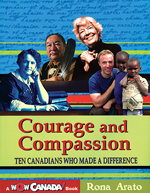
Courage and Compassion
by Rona Arato
This wonderful collection from the Wow Canada series is a celebration of Canadians,
our history and our promise. The profiles of human rights champions who strove
to protect basic freedoms span the Canadian story. Students will particularly
identify with two of the younger activists, Craig Kielburger, who developed
a sense of social and global responsibility when he was 12, and Hannah Taylor,
who tackled homelessness in her native Winnipeg at the age of five.
Also profiled are Jeanne Mance, Josiah Henson, Nellie McClung, Lester B. Pearson,
Roger Obata, June Callwood, Judy Feld Carr and Elijah Harper. Summaries of
their lives and work blend fascinating narratives with illustrations and photos.
The stories show the choices that each of them made when facing situations
they knew to be wrong.
This is an excellent resource for Junior through Senior grades and could be
used in conjunction with Persons Day, UN Day for Human Rights, International
Day for the Elimination of Racism and other events. June Callwood is quoted:
“If you see an injustice being committed, you’re not an observer, you’re a
participant.” This book helps students to make that connection and perhaps
choose to be participants and leaders for change.
 Courage
and Compassion: Ten Canadians Who Made a Difference, Maple Tree
Press, Toronto, 2008, softcover, ISBN 978-1-897349-35-9, 96 pages, $19.95,
distributed by Raincoast Books, tel 604-323-7106 or 1-800-663-5714, customerservice@raincoast.com,
www.raincoast.com Courage
and Compassion: Ten Canadians Who Made a Difference, Maple Tree
Press, Toronto, 2008, softcover, ISBN 978-1-897349-35-9, 96 pages, $19.95,
distributed by Raincoast Books, tel 604-323-7106 or 1-800-663-5714, customerservice@raincoast.com,
www.raincoast.com
Nadira Baksh, OCT, is pursuing library and Special Education AQs and participating
on various literacy-related committees and the Understanding the Early Years
project, while on leave from her Junior/Intermediate classroom duties.
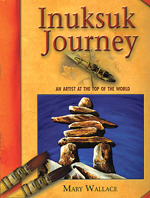
Inuksuk Journey
by Mary Wallace
In the summer of 2008 Canadian artist and author Mary Wallace travelled to
Canada’s Arctic in a quest for deeper understanding of traditional Inuit living.
Inuksuk Journey is a chronicle of that adventure. The book takes the form of
journal entries and is illustrated with vibrant artwork of landscapes, flowers,
wildlife and the people of the north. This makes for a multi-sensory impression
that lingers long after closing the book.
Wallace is particularly affecting in her understanding of the transience of
life in the Arctic and the intense connection the people have with the land
and its wildlife. In portraying their daily lives, she highlights the wisdom
they derive from their rich past and their understanding of how that past impacts
their present and future.
The book offers stellar examples of journal writing and the use of both text
and art to convey thoughts and feelings. Students in Grade 5 and above would
benefit from this example when chronicling any trip they may take (even a trip
to the supermarket). I recommend this book because its lavish artwork and expressive
text create a landscape for children to wander into and get to know.
 Inuksuk
Journey: An Artist at the Top of the World, Maple Tree Press,
2008, hardcover, ISBN 978-1-897349-26-7, 64 pages, $24.95, distributed by Raincoast
Books, tel 604-323-7106 or 1-800-663-5714, customerservice@raincoast.com, www.raincoast.com Inuksuk
Journey: An Artist at the Top of the World, Maple Tree Press,
2008, hardcover, ISBN 978-1-897349-26-7, 64 pages, $24.95, distributed by Raincoast
Books, tel 604-323-7106 or 1-800-663-5714, customerservice@raincoast.com, www.raincoast.com
Sandra Jack-Malik, OCT, is a second-year PhD student in elementary education
at the University of Alberta.

Inside Hockey!
by Keltie Thomas
During an infamous hockey game in the 1960s, fans in Rhode Island threw hot
pennies onto the ice to stop the opposing team. Phil Esposito wore a black
turtleneck as a good-luck charm. Gerry Cheevers was the first goalie to decorate
his mask. These are just a few of the tidbits of hockey lore about players
on and off the ice in this fact-filled book aimed at eight- to 12-year-olds.
The book’s eight chapters, with their colourful illustrations and photographs,
cover a range of topics including scoring goals, goalies, practical jokes,
mischief makers, superstitions, the Stanley Cup, how to become an NHL player
and fighting. “Science at play” insets spotlight the science behind hockey.
Women’s hockey is also featured and a full index is included.
The author’s experience as a former editor of OWL magazine and the author
of numerous books about sports is clearly evident. Readers of all ages, even
otherwise reluctant readers who love hockey, will enjoy this book.
 Inside
Hockey!, Maple Tree Press, Toronto, 2008, softcover, ISBN 978-1-897349-29-8,
64 pages, $12.95, distributed by Raincoast Books, tel 604-323-7106 or 1-800-663-5714,
customerservice@raincoast.com, www.raincoast.com Inside
Hockey!, Maple Tree Press, Toronto, 2008, softcover, ISBN 978-1-897349-29-8,
64 pages, $12.95, distributed by Raincoast Books, tel 604-323-7106 or 1-800-663-5714,
customerservice@raincoast.com, www.raincoast.com
Margaret Grift is a library consultant in Brampton.

Lunch with Lenin and Other Stories
by Deborah Ellis
This gripping collection of young adult short stories delivers a chilling
portrayal of “those who struggle to make their way” (to whom the book is dedicated).
It is a subtle and sophisticated collection that requires careful previewing
for classroom appropriateness prior to being offered to students. With that
proviso in place, I highly recommend it.
The stories depict the lives of 10 teenagers who are directly or indirectly
involved with drugs. Their vivid lives and desperate situations are portrayed
in simple language, but their experiences are as complex as they are heartbreaking.
Settings include locations in North America, Afghanistan, Russia, the Philippines,
Mongolia and Bolivia.
In the first story we meet Matthew, a straight-A student who rolls and smokes
a joint with his grandmother in her nursing home to ease her physical pain.
The following nine stories are equally full of thought-provoking contexts and
social issues. From the opium fields of Afghanistan to hardcore heroin addicts
on the streets of Moscow, we see the similarities of lives controlled and often
destroyed by drugs. Crystal meth, ecstasy, glue sniffing, child neglect, police
corruption and rehab are just a few of the themes that may prompt discussions
about rich and poor, right and wrong, the war on drugs and whether the end
justifies the means.
 Lunch with Lenin and Other Stories, Fitzhenry and Whiteside, Markham,
2008, softcover, ISBN 978-1-55455-105-7, 192 pages, $14.95, tel 905-477-9700,
godwit@fitzhenry.ca, www.fitzhenry.ca Lunch with Lenin and Other Stories, Fitzhenry and Whiteside, Markham,
2008, softcover, ISBN 978-1-55455-105-7, 192 pages, $14.95, tel 905-477-9700,
godwit@fitzhenry.ca, www.fitzhenry.ca
Andrea Murik, OCT, is a Special Education resource teacher at Angus Morrison
Elementary School in Angus.
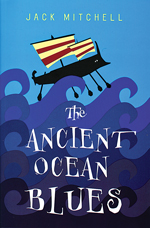
The Ancient Ocean Blues
by Jack Mitchell
Set in Rome before the rise of Julius Caesar, this novel reads like a movie
script. Marcus, a young plebe, comes to Rome to assist his cousin Gaius, a
resourceful but unscrupulous lawyer. Marcus offers bribes to the friends of
Julius Caesar to gain their support and is entrusted with an errand that leads
him into great danger. Along the way we meet Cicero, Pompey and Homer in this
action tale of excitement and coincidences.
Shipwrecks, sea battles with Sicilian pirates, an aristocratic Roman heroine
and Spartans fill the stage. With a little curiosity about the ancient Roman
world, the reader will be well satisfied and want to learn more about Greek
philosophy, the geography of the Mediterranean, the movement of power and how
the politics of those times have a laid a foundation for our own.
As a novel that is both highly entertaining and intellectually stimulating,
The Ancient Ocean Blues is a great way to introduce teens to the ancient world.
The Toronto-based author’s interest in classics was first piqued at age 14
when he read J.R.R. Tolkien’s Lord of the Rings. His admiration for the book
led him to study Latin in high school and he now holds a PhD in classics from
Stanford University. Warn your students that a future in classics could be
theirs if they read this book!
 The Ancient Ocean Blues, Tundra Books, Toronto, 2008, softcover, ISBN
078-0-88776-832-3, 192 pages, $11.99, tel 1-800-788-1074, tundra@mcclelland.com,
www.tundrabooks.com The Ancient Ocean Blues, Tundra Books, Toronto, 2008, softcover, ISBN
078-0-88776-832-3, 192 pages, $11.99, tel 1-800-788-1074, tundra@mcclelland.com,
www.tundrabooks.com
Mary Veronica Moloney, OCT, teaches Grades 4 and 5 at D’Arcy McGee Catholic
School in Toronto.

The Joys of Teaching Boys
by Christopher M. Spence
After outlining the rapid decline in boys’ academic performance, Christopher Spence describes the alienation, anger, violence and underachievement that have resulted. He cites the tragic story of 15-year-old Jordan Manners who was shot dead in his Toronto school hallway. A former CFL athlete, teacher, principal, superintendent and now Director of Education at the Toronto DSB, Spence brings a wealth of knowledge and experience to his proposals for improving literacy among boys.
Spence challenges teachers to re-evaluate their attitudes toward male energy – to see it as a positive force, rather than a disruptive obstacle, in stimulating thought. Even in reading and writing, he notes, action is imperative. For example, boys much prefer narrative writing over descriptive or expository writing. Spence discusses the influence of testosterone on competitive behaviour and advises against the current trend to sanitize boys’ writing by not allowing any “blood and guts.” Finally, he persuasively advocates for single-gender schools, citing their “honourable” history in many cultures and settings.
Spence is an educator with a strong vision who is strategically placed to implement some of his own ideas. This is a man to watch and a book that every educator should read!
 The Joys of Teaching Boys: Igniting Writing Experiences That Meet the Needs of All Students, Pembroke Publishers, Toronto, 2008, softcover, ISBN 978-1-55138-230-2, 112 pages, $24.95, tel 905-477-0650 or 1-800-997-9807, www.pembrokepublishers.com The Joys of Teaching Boys: Igniting Writing Experiences That Meet the Needs of All Students, Pembroke Publishers, Toronto, 2008, softcover, ISBN 978-1-55138-230-2, 112 pages, $24.95, tel 905-477-0650 or 1-800-997-9807, www.pembrokepublishers.com
Michael Reist, OCT, is head of the English department at Robert F. Hall Catholic SS in Caledon East.
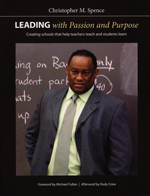
Leading with Passion and Purpose
by Christopher M. Spence
When I graduated from teacher’s college, I was filled with the sense of purpose that comes from knowing that individuals really can make a difference in the lives of marginalized or disenfranchised people. In this book Christopher Spence speaks to that optimism by demonstrating a clear understanding of the importance of moral purpose in inspiring educators.
Spence recognizes that student achievement is invariably linked to the passion that teachers, administrators and support staff bring to their students’ education. For Spence, quality schools are those where everyone believes that all children can learn and where the community is involved in bringing this to fruition.
Leading with Passion and Purpose offers both an understanding of the big picture of education reform in Ontario and an appreciation of the small things that truly make a difference in the lives of children and their families. Spence makes an important contribution to a body of writing about student achievement and school reform. This is a must read for those who wish to understand how to bring about student success in our schools.
 Leading with Passion and Purpose: Creating Schools That Help Teachers Teach and Students Learn, Pembroke Publishers, 2009, softcover, ISBN 978-1-55138-236-4, 128 pages, $24.95, tel 905-477-0650 or 1-800-997-9807, www.pembrokepublishers.com Leading with Passion and Purpose: Creating Schools That Help Teachers Teach and Students Learn, Pembroke Publishers, 2009, softcover, ISBN 978-1-55138-236-4, 128 pages, $24.95, tel 905-477-0650 or 1-800-997-9807, www.pembrokepublishers.com
Michael Bellrose, OCT, is the principal of CR Judd Public School in Capreol.
French-language resources
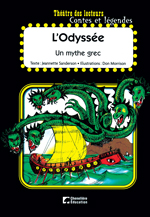 Le Théâtre des lecteurs Le Théâtre des lecteurs
Series
Here are two series of booklets for reading aloud. One series, Les contes et légendes, presents modern plays based on tales and popular legends; the other series, Les classiques, offers classical stories from different cultures. The booklets provide activities that integrate reading, writing and listening. By using different volumes, rhythms and tones, students learn that reading can be a creative activity. These mini resources are amusing and can improve students’ confidence and enthusiasm for reading.
The booklets in Les contes et légendes are intended for Grade 4 students. Les classiques targets students in Grades 5 and 6 and provides information on the literary works. Both series include questions intended to deepen the student’s interpretation of the text, as well as a list of words and figures of speech. Teaching guides are included and suggest additional activities.
Le Théâtre des lecteurs requires no costumes, makeup, stage or memorizing of lines. This very simple approach to working on oral expression can be carried out in a classroom setting.
 Le Théâtre des lecteurs: Contes et légendes (series)and Classiques (series), Chenelière Éducation (Didactique), Montréal, 2008, ISBN 9782765024224, complete set of 24 booklets $180.25, tel 1-800-565-5531, clientele@cheneliere.ca, www.cheneliere.ca. Le Théâtre des lecteurs: Contes et légendes (series)and Classiques (series), Chenelière Éducation (Didactique), Montréal, 2008, ISBN 9782765024224, complete set of 24 booklets $180.25, tel 1-800-565-5531, clientele@cheneliere.ca, www.cheneliere.ca.
Colleen Coutu, OCT, is a teacher-librarian in an early immersion program at Walter E. Harris PS in the Durham DSB in Oshawa.
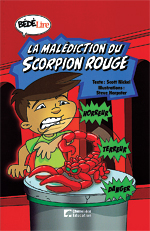 Bédélire Bédélire
Series
Here are two series of booklets for reading aloud. One series, Les contes et légendes, presents modern plays based on tales and popular legends; the other series, Les classiques, offers classical stories from different cultures. The booklets provide activities that integrate reading, writing and listening. By using different volumes, rhythms and tones, students learn that reading can be a creative activity. These mini resources are amusing and can improve students’ confidence and enthusiasm for reading.
The booklets in Les contes et légendes are intended for Grade 4 students. Les classiques targets students in Grades 5 and 6 and provides information on the literary works. Both series include questions intended to deepen the student’s interpretation of the text, as well as a list of 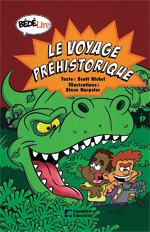 words and figures of speech. Teaching guides are included and suggest additional activities. words and figures of speech. Teaching guides are included and suggest additional activities.
Le Théâtre des lecteurs requires no costumes, makeup, stage or memorizing of lines. This very simple approach to working on oral expression can be carried out in a classroom setting.
 Le Théâtre des lecteurs: Contes et légendes (series)and Classiques (series), Chenelière Éducation (Didactique), Montréal, 2008, ISBN 9782765024224, complete set of 24 booklets $180.25, tel 1-800-565-5531, clientele@cheneliere.ca, www.cheneliere.ca. Le Théâtre des lecteurs: Contes et légendes (series)and Classiques (series), Chenelière Éducation (Didactique), Montréal, 2008, ISBN 9782765024224, complete set of 24 booklets $180.25, tel 1-800-565-5531, clientele@cheneliere.ca, www.cheneliere.ca.
Colleen Coutu, OCT, is a teacher-librarian in an early immersion program at Walter E. Harris PS in the Durham DSB in Oshawa.
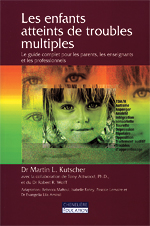 Les enfants atteints de troubles multiples Les enfants atteints de troubles multiples
by Martin L. Kutscher, Tony Attwood and Robert R. Wolff
It may take time for a parent or teacher to recognize that a child has special needs. This book, to be used as a guide, presents various disorders that may afflict a child and the diagnoses that follow upon assessments made by specialists.
The book is directed at parents, teachers and professionals – all members of a team whose common goal is to help the child. Given that multidisciplinary teams have been set up within the school boards, the approach seems highly relevant.
The first two chapters present the two main rules that make it possible to influence a child’s behaviour (remain positive; remain calm) and consider various situations as illustrations. Chapters 3 to 13 are devoted to disorders and syndromes that tend to coexist and that, according to the authors, “negatively influence each other.” For example, if a child suffers from attention deficit disorder and learning disabilities, the problem with concentration will make learning more difficult and the problem with learning will in turn discourage concentration.
The final chapter, devoted to medication, specifies that the information provided is not exhaustive and should not be taken as medical advice. Included at the end are appendices, a reference list and complementary resources for those hoping to deepen their knowledge of this subject.
This is a very useful book and a good reference that should be in your library.
 Les enfants atteints de troubles multiples: Le guide complet pour les parents, les enseignants et les professionnels, Chenelière Éducation (Didactique), Montréal, 2008, ISBN 9782765021872, 232 pp, $29.95, tel 1-800-565-5531, clientele@cheneliere.ca, www.cheneliere.ca. Les enfants atteints de troubles multiples: Le guide complet pour les parents, les enseignants et les professionnels, Chenelière Éducation (Didactique), Montréal, 2008, ISBN 9782765021872, 232 pp, $29.95, tel 1-800-565-5531, clientele@cheneliere.ca, www.cheneliere.ca.
Madeleine Zaffarano, OCT, is a remedial teacher with the Conseil scolaire de district du Centre-Sud-Ouest in Toronto.
For past reviews, visit the archives. |

